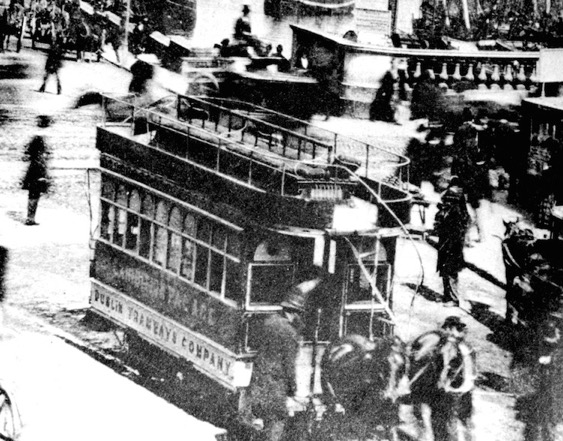Dublin Tramways Company
History
The first of Dublin's horse tramway companies — the City of Dublin Tramways Company — obtained an Order in Council in May 1867 to construct a tramway linking three of Dublin's early railway termini (at Kingsbridge, Western Row and Harcourt Street). Although a trial section of tramway was built, objections to the rails used, which probably stood proud of the road surface, were so numerous, that the scheme got no further. In 1871, these powers were acquired by a new company, namely, the Dublin Tramways Company. The company was probably incorporated by the Dublin Tramways Act 1871, which authorised its promoters to build circa 17 miles of tramways to the Irish Standard Gauge of 5ft 3ins, including lines to Clontarf, Glasnevin, Phoenix Park, Terenure, Donnybrook, Sandymount, and along North Quays.
The first line to open ran from College Green to Rathgar on the 1st February 1872, and was later extended at both ends to Nelson Pillar and Terenure. The line linking the three stations — the South Quays line — followed in June 1872, Sandymount in October 1872, Donnybrook in March 1873, Clontarf on the 31st May 1873 (extended to Dollymount by the October), and North Quays on the 16th April 1874. Although the company acquired powers to build more lines in 1873, the company never built them, nor did it build two of the lines it held powers for from the earlier act of 1871. Although its trams were well patronised (on most routes), the company's profits were disappointing, and this, together with what were evidently serious disagreements amongst the directors, led to the resignation of the Managing Director, William Barrington.
Barrington was, however, not a man to take this lying down, and soon reappeared to promote a scheme to build tramways out to the north of the River Liffey, to serve the less well-to-do citizens, a scheme he appears to have been personally passionate about. The DTCo already held powers to construct tramways in the area, but had chosen not to exercise them; however, as there was a time limit on construction, their failure to act eventually allowed Barrington and his associates to acquire new powers, which were granted on the 11th August 1875 under the North Dublin Street Tramways Act, 1875. The same act also authorised the promoters to incorporate a company — the North Dublin Street Tramways Company — to finance, build and operate the planned tramways. Further powers were acquired in 1876, which included another line that the DTCo had failed to build (to Inchicore), all of which ensured that relations between the two companies were hardly cordial. Barrington's departure did, however, allow the DTCo to restructure its management, and to implement measures that greatly improved its profitability.
At its height, the DTCo operated 16.5 miles of horse tramway, including a complex network of lines in the city centre, where many tracks served multiple routes. In addition to city-centre lines running east-west along the North and South Quays, lines ran northwestwards via Amines Street, Strand Road, Fairview Road, and Clontarf to a terminus in Dollymount; southeastwards via Nassau Street, Mount Street, and Bath Avenue to a terminus at Sandymount Tower; southeastwards via Nassau Street, Lower Fitzwilliam Street, and Morehampton Road to a terminus near Donnybrook Church; and southwards via Dawson Street, Richmond Road, Rathmines and Rathgar to a terminus in Terenure.
Rather than obstructing each other, which served neither the populace nor their shareholders, the three main horse tramway companies — the Dublin Tramways Company (16.5 miles; 82 tramcars), the North Dublin Street Tramways Company (8 miles; 25 tramcars) and the Dublin Central Tramways Company (6.5 miles; 30 tramcars) — agreed, on the 13th July 1880, to merge into one larger entity, to be called the Dublin United Tramways Company. The amalgamation required legislation — the Dublin United Tramways (Amalgamation of Companies) Act of 1881 — the DUTCo formally coming into being on the 1st July 1881.
Uniforms
Photographs which unequivocally date from the above period are very rare, and those that have survived do not show crew members at all clearly; it is therefore impossible to state with any degree of certainty whether or not horsecar crews wore uniforms, or for that matter, any other form of official insignia such as cap badges or licence badges. However, given that the successor company — the DUTCo — did not see fit to issue uniforms to its tramcar crews until the advent of electrified services, some sixteen years after the amalgamation, it seems highly likely that staff of the DTCo simply wore informal attire: jackets, shirt and ties, along with the fashionable headgear of the day, in all probability the bowler hat.
Further reading
For a short history of this system, see: 'Through Streets Broad and Narrow' by Michael Corcoran; Midland Publishing (2000).
Images
Horse tram drivers and conductors
An unidentified DTCo horsecar at the corner of Bachelor's Walk and Carlisle Bridge (renamed O'Connell Bridge in 1882) — photo undated, but given the Dublin Tramways Company name on the rocker panel, and the fact that Carlisle Bridge appears to still be in its unwidened form, certainly taken prior to 1877. It is unclear which of the two figures either side of the horses is the driver, though both men appear to be wearing informal attire, along with trilby hats. Photo courtesy of Jim Kilroy, tram archivist at the National Transport Museum (see link).